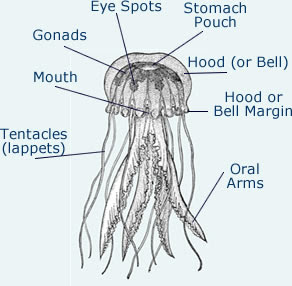 |
| Are jellyfish fish? |
I have to honest and say that I am surprised that this question is even being asked. While it is true that the compound word 'Jellyfish' is a common name that has arisen from a rudimentary description of the organism, and that it is also true that it does indeed contain the word 'jelly' and 'fish', the jellyfish is not a fish and it is definitely not made from jelly. Furthermore, I implore you not to test this statement by chewing on one.
The English popular name jellyfish has been in use since 1796, however other scientists prefer to use the more all-encompassing term gelatinous zooplankton! Obviously, jellyfish is far easier to say.
What are Jellyfish?
 |
| Fish made of Jelly - not a Jellyfish |
Jellyfish are an invertebrate (an animal species that do not develop a vertebral column) species of sea dwelling animal that are so named due to their gooey gelatin-like bodies.
They belong to the Cnidaria phylum, which includes other simple-bodied marine invertebrates such as sea anemones and corals.
The jellyfish is considered simple-bodied because, like its Cnidarian cousins, it has no head, brain, heart, eyes, or ears. Thus it is also lacking in the sensory systems that correspond to these organs.
Jellyfish are pretty simple creatures. They are composed of three layers: an outer layer, called the epidermis; a middle layer made of a thick, elastic, jelly-like substance called mesoglea; and an inner layer, called the gastrodermis.
 |
| Anatomy of a Jellyfish - no fish, no jelly |
The simple digestive cavity of a jellyfish acts as both its stomach and intestine, with one opening for both the mouth and the anus.
There are over 2,000 species of jellyfish, or jellies as they are sometimes called. Fossil evidence of these creatures dates back to over 650 million years ago, during the late Proterozoic Era.
With so many species of cnidarians floating about, there is a certain amount of variety in the appearance of their body parts. While the typical body is composed of a bell, oral or feeding arm and the tentacles, there are some species that do not have tentacles.
Click here for related articles:
PORTUGUESE MAN OF WAR STINGS
DO FISH SLEEP







No comments:
Post a Comment